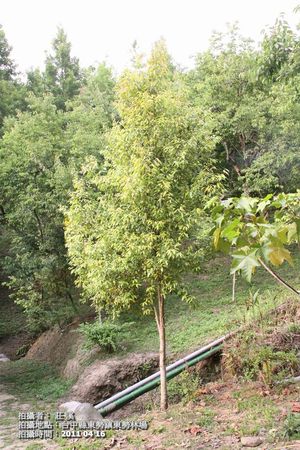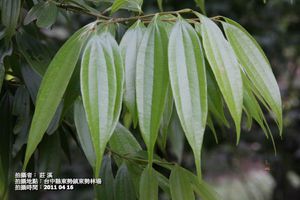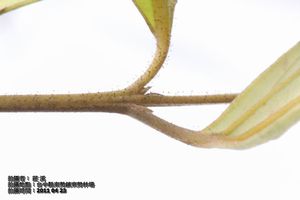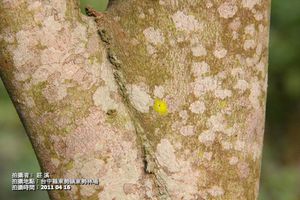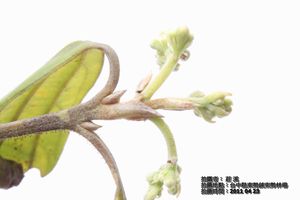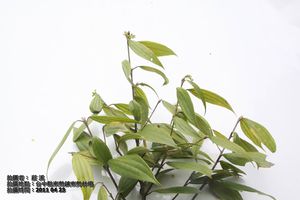香桂
出自台灣有毒中草藥毒性資料庫
(→參考文獻) |
|||
| 第123行: | 第123行: | ||
3. Cheng M-J, Tsai I-L, Chen I-S. [http://www.airiti.com/ceps/ec/ecjnlarticleView.aspx?jnlcattype=0&jnlptype=0&jnltype=0&jnliid=3598&issueiid=62770&atliid=1065797 Chemical Constituents from Strychnos cathayensis.] ''Journal of the Chinese Chemical Society'' 2001; 48: 235-240. | 3. Cheng M-J, Tsai I-L, Chen I-S. [http://www.airiti.com/ceps/ec/ecjnlarticleView.aspx?jnlcattype=0&jnlptype=0&jnltype=0&jnliid=3598&issueiid=62770&atliid=1065797 Chemical Constituents from Strychnos cathayensis.] ''Journal of the Chinese Chemical Society'' 2001; 48: 235-240. | ||
| - | 4. Chen CH, Lo WL, Liu YC, Chen CY. [www.ncbi.nlm.nih.gov/pubmed/16792412 Chemical and cytotoxic constituents from the leaves of Cinnamomum kotoense.] ''Journal of Natural Products'' 2006; 69: 927-933. | + | 4. Chen CH, Lo WL, Liu YC, Chen CY. [http://www.ncbi.nlm.nih.gov/pubmed/16792412 Chemical and cytotoxic constituents from the leaves of Cinnamomum kotoense.] ''Journal of Natural Products'' 2006; 69: 927-933. |
5. Chen CY, Chen CH, Wong CH, Liu YW, Lin YS, Wang YD, Hsui YR. [http://www.ncbi.nlm.nih.gov/pubmed/18175985 Cytotoxic constituents of the stems of Cinnamomum subavenium.] ''Journal of Natural Products'' 2007; 70: 103-106. | 5. Chen CY, Chen CH, Wong CH, Liu YW, Lin YS, Wang YD, Hsui YR. [http://www.ncbi.nlm.nih.gov/pubmed/18175985 Cytotoxic constituents of the stems of Cinnamomum subavenium.] ''Journal of Natural Products'' 2007; 70: 103-106. | ||
在2011年12月4日 (日) 13:20所做的修訂版本
基本資料
|
科別 | 樟科 Lauraceae |
|
屬名 | 樟屬 Cinnamomum |
|
中文學名 | 香桂 |
|
拉丁學名 |
Cinnamomum subavenium Miq. Cinnamomum bartheifolium Hayata Cinnamomum randaiense Hayata |
|
英文名稱 | Fragrant Cinnamon, Randaishan Cinnamon-tree |
|
中文俗名 | 巒大香桂、巒大桂、細葉香桂、細葉月桂、細葉肉桂、香樹皮、山肉桂、巒大山肉桂、巒大肉桂、九芎、長果樟 |
植物圖片
|
香桂全株 |
香桂葉 |
香桂嫩枝 | |
|
香桂莖 |
香桂花苞1 |
|
香桂簡介
香桂主要產在東南亞一帶,例如緬甸、柬埔寨、中國南方、馬來西亞及印度,在台灣也可發現香桂的蹤跡。香桂有多種具經濟價值的用途,樹皮可提煉精油,供化粧用品等作為添加香精的原料;葉可提煉葉油亦可作食品,香煙的香料,或供做殺菌劑;綠化樹種:可栽植在庭圓、道路作綠化美化或行道樹用;建材或作傢俱用:木質線細,木理通直而稍細緻;乾燥容易,少反翹、開裂,可作建築(門窗、壁板、板類)、器具、枕木用材。
外觀簡述
|
莖 | 中喬木,高可達 20 餘公尺,徑 30~60 公分,樹皮暗褐色;小枝細長,有褐色毛茸,略帶有稜角。 |
|
葉 | 葉剛長出來時有褐色毛茸,老時僅葉背面有褐色的絹毛,長橢圓狀披針形或卵狀橢圓形,長 6~12 公分,寬 2~4 公分,先端漸尖,基部銳或楔形,革質,明顯的三出脈,於表面顯著凹下,背面隆起,表面呈有光澤的綠色,背面有密生毛茸,尤以葉脈處為多;葉柄長 0.7~0.9 公分,有毛茸。 |
|
花 | 花多數,小形,黃綠色,徑約 0.2 公分,呈頂生或腋生的聚繖狀圓錐花序,花序及花梗有白色絨毛,花被片 6 片,橢圓形,長 0.25~0.3 公分,寬 0.15 公分,先端鈍,表裏兩面皆具有毛茸;完全雄蕊 9 枚,花絲具有薄絨毛,花藥橢圓形,背部有微絨毛,第三輪花絲有腺體,腺體近似無柄;退化雄蕊箭形,柄上有絨毛,長 0.06 公分,花藥 4 室,第三輪外向,其他 2 輪內向;子房橢圓形,光滑,長約 0.15 公分,花柱長 0.2 公分,光滑無毛。 |
|
果實 | 果實長橢圓形或橢圓形,長 1.2~1.5 公分,寬 0.5~1 公分,成熟時呈藍黑色;基部襯托先端截斷狀殘存的花被。 |
產地
廣泛分布於印度、緬甸、高棉、越南、馬來西亞、印尼、中國大陸東南(安徽、浙江、江西及福建等地)及台灣。香桂生長於臺灣嘉義以北中海拔 500~2,100 公尺處山區森林中,數量頗多,常為大喬木,佔據森林的上層。
毒性研究
香桂在民俗醫療中主要用於治療腹痛、胸痛、疝氣及腫瘤膨脹等疾病。目前研究發現香桂主要含有的成分為倍半萜類、三萜類、butanolides、多酚類(polyphenol)、固醇類(steroids)[1-8]等。
- 機轉
Chen et al.於2007年自葉部分離出isoobtusilactone A,然後利用HepG2細胞株來進行體外的毒性測試,結果發現isoobtusilactone A可引起劑量相關性的細胞生長抑制,半數抑制劑量IC50為37.5 microM,同時也發現isoobtusilactone A可促進細胞的sub-G1數量及DNA斷裂增多,粒線體膜外cytochrome c濃度也上升導致caspase 3被活化及PARP cleavage而促使細胞凋亡;但在動物實驗中給予350及700 mg/kg的isoobtusilactone A給予5-6週大的Sprague Dawley老鼠,並沒有發現明顯的動物毒性[9]。Liu et al.及Wang et al.兩組人於2011年分別各以Subamolide A及E測試其對細胞的毒性,Liu發現subamolide A可促進NTBU1細胞的粒線體改變,透過活化p53及ERK1/2引起細胞凋亡[10];而Wang則發現subamolide E則可影響A375.S2細胞的生長週期,提高sub-G1期的數量,並且透過活化caspase 3, 6, 7, 9及PARP而導致細胞凋亡[11]。
- 毒性成分
- isoobtusilactone A[9]
- Subamolide A[10]
- Subamolide E[11]
治療方式
目前並無任何特殊治療方式,均以支持性療法來治療。
毒性分級
參考文獻
1. Kojima H, Sato N, Hatano A, Ogura H. Sterol glucosides from Prunella vulgaris. Phytochemistry 1990; 29: 2351-2355.
2. LI J, KADOTA S, KAWATA Y, HATTORI M, XU GJ, NAMBA T. Constituents of the Roots of Cynanchum bungei DECNE.Isolation and Structures of Four New Glucosides, Bunngeiside-A, -B, -C, and -D. Chemical & Pharmaceutical Bulletin 1992; 40: 3133-3137.
3. Cheng M-J, Tsai I-L, Chen I-S. Chemical Constituents from Strychnos cathayensis. Journal of the Chinese Chemical Society 2001; 48: 235-240.
4. Chen CH, Lo WL, Liu YC, Chen CY. Chemical and cytotoxic constituents from the leaves of Cinnamomum kotoense. Journal of Natural Products 2006; 69: 927-933.
5. Chen CY, Chen CH, Wong CH, Liu YW, Lin YS, Wang YD, Hsui YR. Cytotoxic constituents of the stems of Cinnamomum subavenium. Journal of Natural Products 2007; 70: 103-106.
6. Lin RJ, Lo WL, Wang YD, Chen CY. A novel cytotoxic monoterpenoid from the leaves of Cinnamomum subavenium. Natural Product Reseach 2008; 22: 1055-1059.
7. Chen CY, Yang WL, Hsui YR. A novel sesquiterpenoid from the roots of Cinnamomum subavenium. Natural Product Reseach 2010; 24: 423-427.
8. Shen KH, Lin ES, Kuo PL, Chen CY, Hsu YL. Isolinderanolide B, a Butanolide Extracted From the Stems of Cinnamomum subavenium, Inhibits Proliferation of T24 Human Bladder Cancer Cells by Blocking Cell Cycle Progression and Inducing Apoptosis. Integrative Cancer Therapies 2010.
9. Chen C-Y, Liu T-Z, Chen C-H, Wu C-C, Cheng J-T, Yiin S-J, Shih M-K, Wu M-J, Chern C-L. Isoobtusilactone A-induced apoptosis in human hepatoma Hep G2 cells is mediated via increased NADPH oxidase-derived reactive oxygen species (ROS) production and the mitochondria-associated apoptotic mechanisms. Food and Chemical Toxicology 2007; 45: 1268-1276.
10. Liu CH, Chen CY, Huang AM, Li JH. Subamolide A, a component isolated from Cinnamomum subavenium, induces apoptosis mediated by mitochondria-dependent, p53 and ERK1/2 pathways in human urothelial carcinoma cell line NTUB1. Journal of Ethnopharmacology 2011; 137: 503-511.
11. Wang HM, Chiu CC, Wu PF, Chen CY. Subamolide E from Cinnamomum subavenium induces sub-G1 cell-cycle arrest and caspase-dependent apoptosis and reduces the migration ability of human melanoma cells. Journal of Agricultral and Food Chemistry 2011; 59: 8187-8192.
